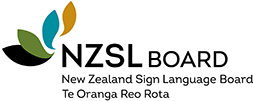Glossary
Access/Accessible: Deaf and other NZSL users are able to access all services and information with ease and dignity through NZSL.
Critical awareness: An understanding of the social and political aspects of their language.
Crown entities: organisations responsible for providing government services as listed by the State Services Commission e.g School Boards of Trustees, District Health Boards and Tertiary Education Institutions. https://www.ssc.govt.nz/sites/all/files/guide-to-central-government-agencies-april17.pdf
Deaf or deaf: The capital ‘D’ is commonly used when referring to Deaf culture and the Deaf community. The NZSL Board have decided on the use of ‘Deaf’ when referring to Deaf adults who identify with the Deaf/NZSL community.
Deaf culture: Shared history, beliefs and behavioural norms of Deaf people, including use of NZSL.
Deaf NZSL users: Deaf adults who culturally identify as a member of the Deaf community and use NZSL.
deaf children/young people: a small ‘d’ for deaf is used to describe children and young people who have a hearing loss and use NZSL and who may/may not identify as a member of the Deaf community.
Deaf domains: Deaf domains are organisations, events, places and spaces (for example, face-to-face or online interaction) where Deaf people are able to use NZSL. Also referred to as ‘Deaf spaces’.
Government agencies: Government agencies as listed by the State Services Commission. https://www.ssc.govt.nz/sites/all/files/guide-to-central-government-agencies-april17.pdf
Maintenance: Actions that ensure the vitality of NZSL as they support conditions enabling NZSL use, transmission and natural development to occur within a community of NZSL users.
NZSL learners: Deaf and hearing people who are learning NZSL.
NZSL users: Deaf and hearing people who use NZSL as either a first or second language.
Promotion: Actions that increase recognition, awareness, acquisition and use of NZSL by New Zealanders.
Transmission or intergenerational transmission: The transference of NZSL from Deaf adults to deaf children.
Use: Deaf users of NZSL are able to use NZSL in all domains of society.
Vitality: The extent to which a language is used as a means of communication in a wide range of contexts for various purposes. The most significant indicator of a language’s vitality is its daily use by the youngest generation of the relevant community.
Page last updated:
